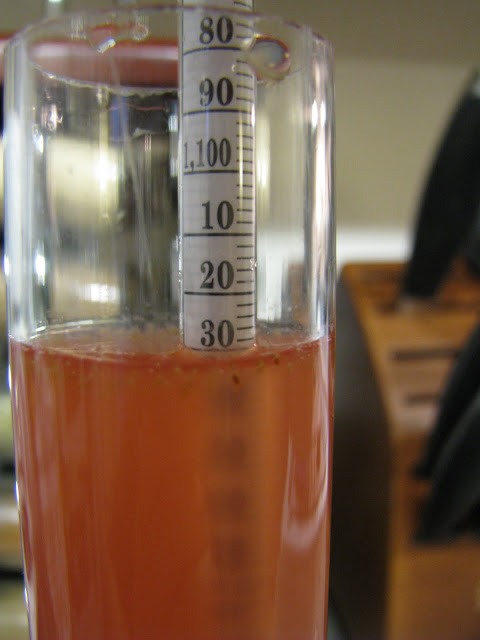Unfortunately, I was unable to snap photos of this brewday like I wanted to, I was in somewhat of a time crunch, and I was already making a mess.
Despite the lack of photos, I can detail my first mead in script.
First and foremost, A quick lesson about prickly pear cactus fruit. The fuit is commonly referred to as Nopales (which I believe is incorrect as it is more accurate to call the actual prickly pear pads nopales). The fruits are also labeled as Indian Figs, cactus figs, or what I think most natives mexicans would refer to as
tunas. The fruits are normally a deep maroon/burgundy color, and covered in glochids (a hairlike spine or needle that easily penetrates the skin, mouth and lips - care must be taken to remove them from the fruits) the cacti are native only to the western hemisphere, but have been introduced to other parts of the globe.
(Hint: a good sign that the fruits are ripe and ready to harvest is when you see the birds eating them, or signs of birds feeding on them.)
Second, the recipe. I basically took Charlie Papazian's Prickly Pear mead Recipe from his book The Complete Joy of Homebrewing 3rd Edition, and put my own spin on it.
20lbs - light honey (mesquite preferred)
5-6lbs - red ripe prickly pear fruits,
tunas.
1/4 tsp - yeast nutrient
1 tbsp - pectin enzyme
1 oz - dried, rehydrated, sherry, wine or champagne yeast.
He details an elaborate method of harvesting and cooking the fruit in preparation it for the mead, but what I did is much simpler, and probably a more effective use of the fruit. For what it's worth, boiling the fruit or honey will drive off much of the aromatic qualities; avoid boiling if possible. Last year sometime, I'd guess around August 2009, I harvested some tunas from the cacti behind my home, I don't know exactly how many pounds of fruit I took off the cacti, but it amounted to 64 oz of pure tuna juice.
I picked the fruit from the caci with a pair of tongs, and handled them with leather gloves. I removed all of the glochids by rubbing the fruits vigorously with my gloves. Afterward, I rinsed them under cool water using the tongs. I proceeded to peel them, halved them, and scooped out the seeds with a spoon, and tossed them into the Cuisinart. I pureed the tunas, and strained as much pulp out as I could manage with a funnel and strainer. I fiiled two 32 oz canning jars, and into the freezer they went, and stayed until this July.
(Hint: an excellent strainer media is a paint strianer bag, or even a reusable coffee filter, be warned though the pulp will clog filters quickly, so make certain to stir while straining, and have more than "filter" available in casr of a clog. Also, be aware these fruits will stain almost anything!)
I filled a pot with 2.5 gallonsof water, added the fruit juice, and pasteurized at ~165°F for about 30 minutes. When the 30 minutes expired, I added the 20 lbs of Mesquite honey to the fruit juice/water mixture, and pastuerized for an additonal 30 minutes. While everything was simmering, I skimmed any scum, and pulp from the surface. In the last 10 minutes of the boil I added my yeast nutrient (DAP/diammonium phosphate, and yeast energizer, which I do not know exactly what the contents are since it is generic from my home brew shop.)
After the time was up, I tried chilling the must as best I could, but I was ill prepared. I didn't have anough ice or chilled water, so I did the best I could with what I had (RDWHAHB, right?). While everything was cooling, I rehydrated 25g of Champagne Yeast in 2.5 cups of 100°F water and let it stand for about 15-20 minutes.
Ironically, after I inoculated the must with the Champagne yeast, I found that it is not the best choice for mead...whatever, it's my first attempt, and I'm sure it will still be good, wait ...no...great!
I poured the contents of the kettle (fruit juice, honey and water mix) into my 6.5 gallon fermenter, and topped up with enough cooled water to make 6.25 gallons. I took a gravity reading:
1.130 @ 64°F = OG 1.130
It's hard to tell in the photos, but the must is the color of pink lemonade.
I checked the temperature of the must and it was still 92°F! I had no choice but to pitch my yeast since it was ready.
Stay tuned...




.jpg)






